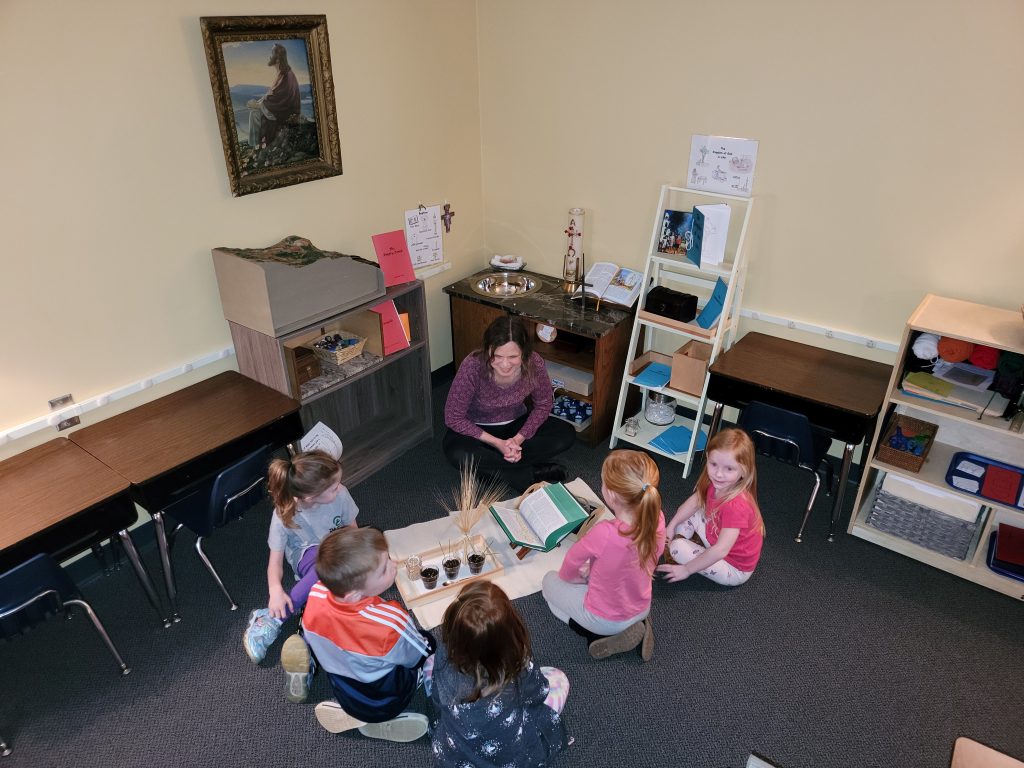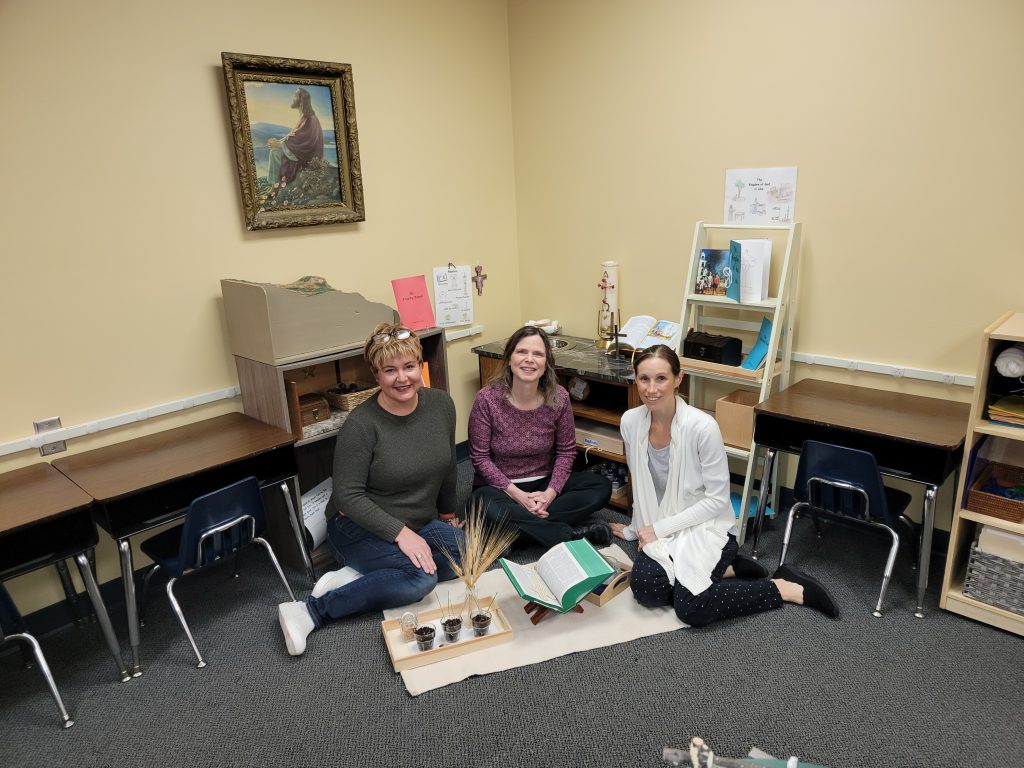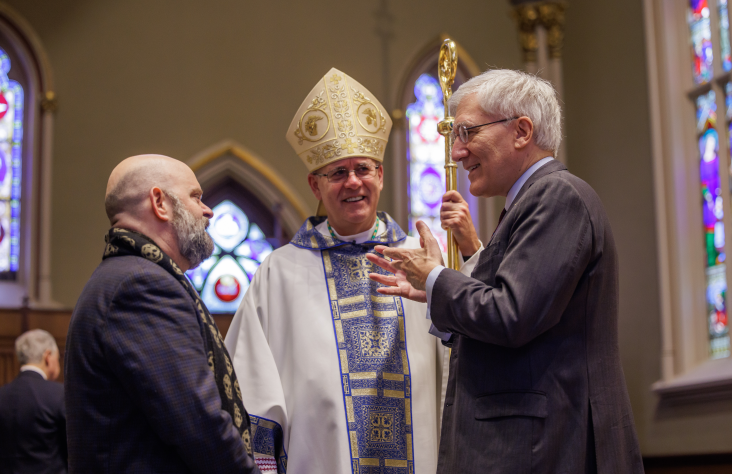May 6, 2022 // Local
Montessori style of catechizing Catholic youth
“Let the children come to me, and do not prevent them; for the kingdom of heaven belongs to such as these.” – Matthew 19:13-15
Many Catholics began their faith education at home during infancy, continuing through Catholic school or Sunday school. Over the years, the manner of catechizing Catholic youth has changed, however. In Rome, Italy, in the year 1954, Sofia Cavalletti and Gianna Gobbi started a Montessori-based way to bring the Gospel to children that has had an impact all over the world.
According to the CGSUSA.org website, Cavalletti was a biblical scholar who held a doctorate in Hebrew and Comparative Semitic Languages. Her education gave her the ability to help the children she taught feel the flame of passion for God’s Word. Gobbi, who had 15 years of classroom experience as a Montessori teacher, was introduced to Cavalletti by a mutual friend.

Photos by Lisa Marie Emrick
Debbie Hillman introduces a lesson to Level 1 students during Catechesis of the Good Shepherd at Our Lady of Good Hope in Fort Wayne.
They began their teaching by creating an atrium, or prepared environment, with a model altar and articles from Mass to guide children and help them build a better understanding of their faith and relationship with God. Cavalletti has been quoted as saying “we started without knowing we started.” This was the birth of Catechesis of the Good Shepherd (CGS).
The environment is the vital piece that allows CGS to guide a child’s relationship with God. When the child is allowed to explore and interact with God’s Word, it uses that experience to teach children. Materials in the atrium are often handmade, sometimes by the instructor, and directors will also ask for parish involvement in making items. If someone can sew, they may be asked to make vestments, or a woodworker can offer to help erect a model altar for the atrium. Every piece in the environment is meant to inspire awe in the child.
Here in the Diocese of Fort Wayne-South Bend, a handful of parishes and schools offer Catechesis of the Good Shepherd.
The system
The CGS approach is divided into three levels. The Level I atrium consists of children who are 3 to 6 years old. Level I is where children become more familiar with Jesus. Jesus is the Good Shepherd; He calls each by name. The focus in Level I is the mystery of the Eucharist and what takes place at the altar by learning names and gestures.
Level II atrium is for children ages 6 to 9, where they learn about the True Vine and what it takes to have a relationship with God and the larger community. The children study the parables and learn how they can relate to the readings. The Mass is also brought to the forefront as one long prayer broken into smaller prayers. In their journey toward making their first Communion, by learning meditations that focus on Jesus and making personal missals, they are strengthened in their understanding and love for the Eucharist.
Level III atrium allows children age 9 to 12 to learn about their place in God’s kingdom and their seat in it. Children are given the history of salvation and are anchored in knowing that humanity is all connected, being made in God’s likeness and image. Materials on the prophets of the Old Testament, the gifts of God, the miracles of Jesus, and expanded presentations on liturgy and Scripture can also be found in the Level III Atrium, according to CGSUSA.org.

Members of Our Lady of Good Hope’s Catechesis of the Good Shepherd program sit in the Level 1 atrium where they teach the younger students. From left are Kelly Ley, Director of Religious Education, Debbie Hillman and Anne Guzman.
Training the teachers
Yova Teusch, a Level I instructor at Our Lady of Good Hope Parish in Fort Wayne, was blessed to have the parish sponsor her certification. Between two summers, she spent 90-plus hours training on the knowledge of child development and the religious characteristics of 3- to 6-year-olds. She also deepened her ability to facilitate meditation on Scripture. Teusch stated: “The biggest blessing of this program is in the way it carefully and gently nurtures the sense of awe and wonder in a child of the concept of the kingdom of God through parables and reflections. … In CGS, a relationship between a child and God is the root of a spiritual formation.”
During training, the catechist will learn about Montessori-style education, CGS, how to build an atrium and how to present the elements of formation. There are scholarships and grants available to offset the cost of training. Many who have gone through this training have stated that the process has helped deepen their faith life as well.
“Through the training and guiding the children in the atrium, I firmly believe that God has revealed Himself to me in many different ways. He is the loving Good Shepherd, who will leave the ninety-nine to find me and lay down His life for His sheep,” Teusch said.
Tessa Mammolenti helps with CGS at Christ the King Church in South Bend. Mammolenti says that each level has two parts of training; Level I is the most extensive. The training is arranged in a retreat-style method. CGSUSA.org states: “It has a holistic approach for the adult, enriching the adult in a background of scripture and liturgy, theology and prayer, as well as the pedagogy of the young child, helping the adult to see what face of God the young child most needs in order to enter into a relationship with God.”
Faith in action
St Pius X Church and School in Granger began their CGS in 2004 with Level I. Theresa DePung, Director of CGS, said that the parish has all three levels, and on average, 420 students go through the program each year. DePung explained, “Young children have a deep religious capacity and hunger to experience the most essential mysteries of our faith. CGS is like a weekly guided retreat in a deeply contemplative environment. During this time, the children are able to immerse themselves in age-appropriate, hands-on materials in a beautiful space to help them ponder more deeply these mysteries.”
St. Pius X has eight catechists trained in Level I, and four trained for Level II. Of those four, two are also trained in Level III.
The Director of Religious Education for Our Lady of Good Hope Parish, Kelly Ley, stated, “The atrium model is not divided up by grades; it is a combined group. Level I is ages 3 to 6, Level II is ages 6 to 9. So, what is beautiful is the children that have been in there for two to four years are really helping the other ones to learn as well. Once a lesson is presented, freedom is given to the children to choose the work they want to do for the rest of that work cycle. A work cycle normally only lasts about an hour and a half.”
Ley said that Our Lady of Good Hope has two rooms dedicated just for the atriums, which serve not only the school but the parish community and area homeschool families. They began by introducing the program into their Sunday school. After the school opened in 2016, students were able to use the atrium. It has been six years since Our Lady has incorporated the program with pastor Father Mark Gurtner’s blessing.
When teaching her students, Teusch remarked that, “It always touched me deeply when the children made a connection between the sheep and us! Their eyes lit up and they joyfully declared: ‘we are the sheep and Jesus is the Good Shepherd!’”
St. Joseph School in South Bend brought CGS to their Sunday school in 2010, Halee Williams said. Adding the program to preschool in 2014 and kindergarten in 2017, Williams is excited to announce that they will be able to offer Level II in fall of 2022. St. Joseph has five Level I catechists, one of whom will be able to lead Level II.
Bringing the lessons home
Children and their parents have found a deepened love for their Catholic faith through the program. Cici and Alice Sharp attend Level I at Our Lady of Good Hope on Thursdays, and have enjoyed their experience with the program. Their favorite part is getting to help set up the prayer table. Monica Bodien, mother to Marilee, who attends on Sundays, said that the biggest difference that she sees from her own Catholic education is Marilee’s knowledge of Scripture and the terminology she understands about the sacraments.
Lucy and Grace Macaluso enjoy the prayer table at St. Joseph School in South Bend. Their mother, Kati, feels like CGS makes faith real for students. Kati says, “My husband and I consider this one of the greatest offerings of our children’s Catholic preschool and elementary school experience.” She shared that her children eagerly speak about Jesus and the faith traditions they learn at CGS. Even at three, children actively seek ways to bring the Church into the home, through prayer corners, Bible stories and Advent wreath traditions.
Compared to Kati’s own catechesis, she believes CGS develops a greater faith life. “I think more traditional programs can feel didactic and distant,” she said. “CGS’s reliance on material objects, scriptural story-telling, and ritual lends a sort of immediacy to the Catholic faith and traditions and captures the relevance and beauty of our faith.”
To learn how to begin a CGS program or become a certified instructor, go to cgsusa.org for information and courses.
The best news. Delivered to your inbox.
Subscribe to our mailing list today.






